Ross Lave Lane, formerly Consterdine Lane*, Denton
Hyde Hall dates from the late 16th century and there is a porch dated 1625 but there are later additions.
It was considerably altered in the 17th century when it was partly faced with brick. It is important in terms of its plan, its timber framing in the traditional architectural style of the North West
and for its internal features.
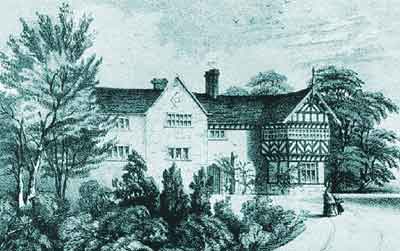
Hyde Hall.
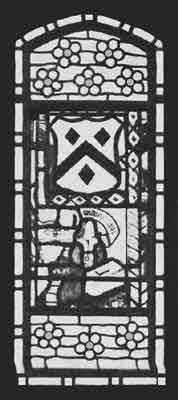
At nearby Denton Chapel (St Lawrence's Church) there is a stained-glass window depicting the arms of the Hyde family of Denton; a shield bearing a chevron between three diamonds. It became fashionable for local landowners to convey their authority by means of heraldic glass in church windows. In this instance their arms occupy the panel above the figure panel. Hyde Hall originally belonged to the Hyde family of Denton which was a younger branch of the Hyde family of Hyde. The first Hyde to settle in Denton, possibly during the period of Edward I (1239-1307) King of England (1272-1307), was Alexander de Hyde. However, the half-timbered hall is mostly of late 16th century construction but the oldest parts may date to the 15th century. There are also additions dating from the 18th century. There is a porch dated 1625 above which are the arms of the Hyde family. Latterly, the Hyde family rarely lived at the hall after which it was occupied by tenant farmers.
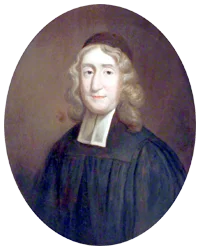
Revd Samuel Angier (8 Aug 1639-8 Nov 1713), nephew of the Revd John Angier (1605-1 Sep 1677) of Denton Chapel (St Lawrence’s). During the Great Plague (1665/66) he regularly travelled around the country preaching but in 1667 he began assisting his elderly uncle at Denton Chapel. In 1672 he was ordained with two others at the residence of the Revd Robert Eaton on Deansgate, Manchester. His uncle, John Angier, attended and this was the first Nonconformist ordination in the North of England. Prior to this he had been granted a licence as a Presbyterian to preach at Hyde Hall, Denton, then the residence of Jane Hyde. This was granted following the Royal Declaration of Indulgence initiated by Charles II to extend religious liberty to Protestant Nonconformists (Puritans) and Roman Catholics by suspending Penal Laws that punished recusants from the Church of England. Charles II introduced his Royal Declaration on the 15 Mar 1672. Following the death of John Angier in 1677 the congregation at Denton Chapel wanted Samuel Angier to succeed him but instead the Fellows of Manchester Collegiate Church (Manchester Cathedral) appointed the Revd John Ogden who was a Conformist. As a consequence, Samuel moved to Dukinfield where he became a minister of Dissenters at Dukinfield Old Chapel (Unitarian) which was built in 1707/08.
When the Hyde Hall estate was sold to William Hulton of Hulton Park, Lancashire, in 1762 it was comprised of 191 acres of land. In 1813 the Hulton family sold the estate to Francis Woodiwis of Manchester and on his death in 1830 it passed to his daughter, Mary Woodiwis. Later the estate was purchased by a Mr Lowe of Reddish and following his death it was purchased by Sir James Watts JP of Abney Hall, Cheadle, who was responsible for some restoration work on the buildings.
The most eminent tenant of Hyde Hall in the 19th century was John Gould (13 Jan 1806-9 Jan 1879). John was born at Parwich, north of Ashbourne, Derbyshire, and he came to Denton to farm at Hyde Hall. Following his arrival he took a prominent part in local affairs, becoming the first elected Guardian of the township. He was also the Surveyor of Highways until the formation of the Local Board of Health. He became an elected member of this Board and its second chairman. He was also a churchwarden at Denton Chapel (St Lawrence's Church) for about 25 years. When Denton Conservative Club was founded in the Bowling Green Inn on Manchester Rd in 1841 he became its first chairman. Gould St, with the Conservative Club on the corner, is named after him. He was buried at Denton Chapel.
The 1851 census records that John Gould was farming 140 acres and employing 10 labourers, six outdoors and four indoors. The same census also records his wife, Ann, and two children, Sarah (b.1832/33) and son, John (b.1835/36). At this time, Hyde Hall Cottage was occupied by Samuel Kirkham (43), a farm labourer, his wife, Ann (31), and their family.
Following the death of John Gould in 1879 the 1881 census shows that the tenant farmer was Joseph Lomas (33). By 1891 John Faulder (54) was the tenant and he described himself as a farm bailiff. The adjoining Hyde Hall Cottage was then occupied by George Faulder (30), a general labourer. In 1911 there is no record of a tenant farmer at Hyde Hall but Hyde Hall Cottage was occupied by George Albert Wiseman (42), a poultry keeper.
Subsequently, the tenant farmer was William Phillips and his wife, Cordelia Alderson, both from Newtown, Powys, Wales. By 1939 he had retired and the farm was being run by his son, Thomas Harold Alderson Phillips. William Phillips’ sons, Benjamin Alderson Phillips and John Stanley Alderson Phillips were tenant farmers of Yew Tree Farm, Stockport Rd, Denton, and Broomstair Farm, Hyde Rd, Haughton, Denton, respectively. Broomstair farm was also the location of C Phillips Ltd, a road haulage company.
In 1939 Hyde Hall Cottage was occupied by John Park (farm labourer) and his wife, Elizabeth.
An interesting feature of Hyde Hall Farm quadrangle is the keystone in the entrance archway, now badly eroded, which is inscribed, MARY WOODIWIS 1839. Mary Woodiwis (1791-1871) was a spinster and the 1851 census records that she was born at Manchester and that she was a land proprietor living in Half St, Manchester, adjoining Manchester Cathedral. She was the daughter of Francis Woodiwis and Mary Grimshaw and she was baptised at the cathedral on the 24 Jul 1791.
In 1846, about one third of the land within the township of Denton was owned by the Egerton family (Earls of Wilton). They leased two thirds of the land they owned to two land proprietors, Miss Mary Woodiwis of Manchester and the trustees of Ellis Fletcher who, until his death, had owned the Clifton Estate in Lancashire, with its substantial coal-mining interests. The remaining one third of land they owned was leased to another 25 land proprietors.
As a prominent land proprietor in Denton, this is probably how Mary's name came to be carved in the keystone but there could be more to it than this. One hypothesis is that there may have been a business connection between the tenant farmer of the day and Mary's father, Francis Woodiwis, who was a currier. A currier is someone who dresses and finished leather after it has been tanned and it is possible that Francis purchased leather made from hides that originated at Hyde Hall. He was described as a man of penurious habits, by which he had amassed a fortune of nearly £100,000.
Francis Woodiwis was the son of Thomas Woodiwis and Rebecca and he died on the 1 May 1830, aged 72 years. Mary Woodiwis died in the Cheetham District of Manchester on the 2 Jan 1871, aged 79 years. Their names are inscribed on a memorial inside St James’s Church, Bonsall, Derbyshire.
In those days, Fennel St connected Hanging Ditch to the north east corner of Manchester Cathedral and Half St, where Mary subsequently lived, was along the east side of the cathedral. A little to the north, on the Salford side of the river Irwell, there was a cattle market between Lord St and Mount St and a tan yard, where leather was made, on the banks of the river Irwell off Queen Ann St.
Hyde Hall is listed Grade II*, List Entry No. 1318129, and the quadrangle of farm buildings is listed Grade II, List Entry No. 1067972. Hyde Hall is presently on the Buildings at Risk Register of English Heritage due to its poor condition. The timber frame is deteriorating and the roof leaks.
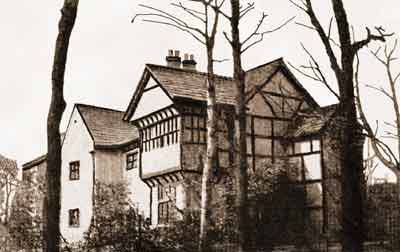 |
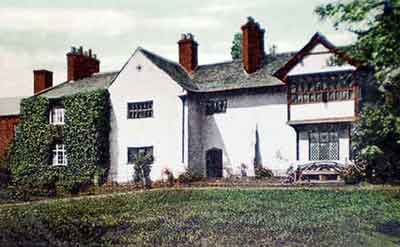 |
| Hyde Hall, with the oriel window in the centre, early 20th century. | Hyde Hall, with the oriel window on the right, early 20th century. |
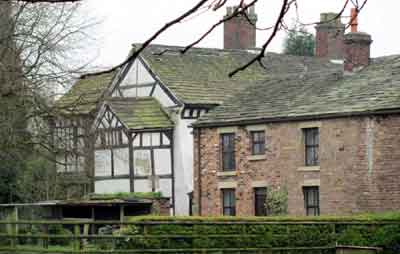 |
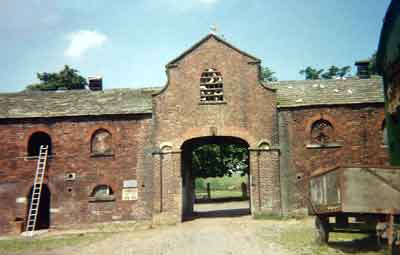 |
| Hyde Hall viewed from The Avenue, Ross Lave Ln. | The quadrangle of Hyde Hall viewed looking towards the entrance from Ross Lave Ln, early 20th century. |
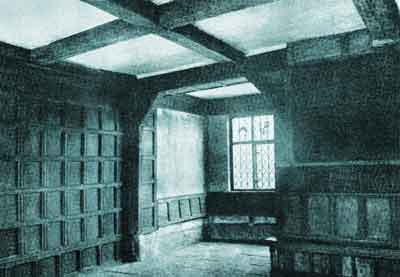 |
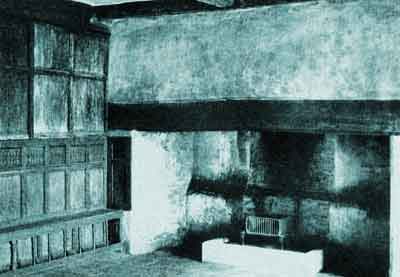 |
| Oriel window. | Fireplace in the great hall. |
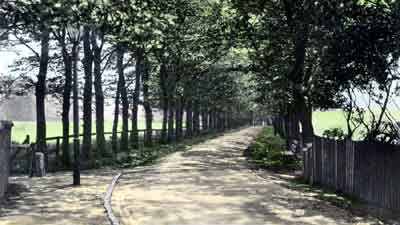 |
The Avenue, Ross Lave Ln, 1930s. |
Further Reading
Farrer, William & Brownbill, J (eds), 1911. A History of the County of Lancaster. Vol. 4. London: Victoria County History.
